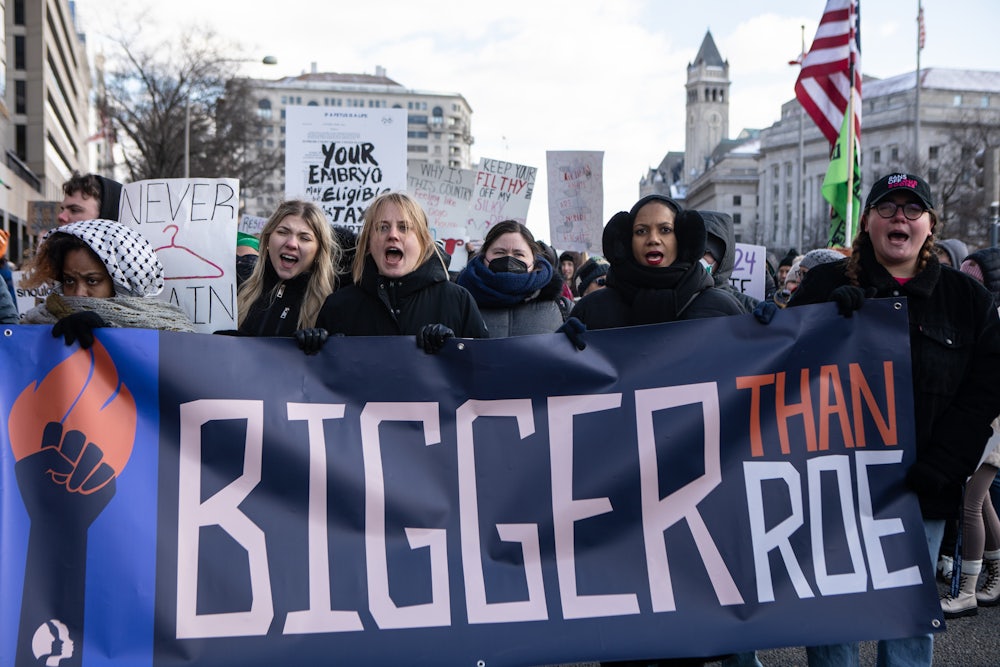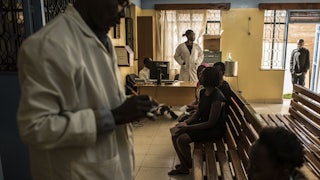In at least 13 states, abortion rights are headed toward the November ballot, and the prevailing hope is that voters mobilized by the end of Roe will show up for reproductive freedom. Through ballot initiatives, voters will decide if their state’s constitution should be updated to guarantee “a right to personal reproductive autonomy,” as one initiative in Maine is formulated. Most, though, would limit this right just as Roe did: by permitting laws that prohibit abortion at the point of “fetal viability,” a line that is not as bright as legislators tend to believe. Similarly, it is almost taken for granted that the way to regain abortion rights is by “restoring Roe.”
“Restoring Roe” is what President Biden has promised to do, should he be reelected. Democrats further down the ballot are repeating this simple story of abortion rights—you lose Roe, you get another Roe—as they too hope to harness voters motivated by the ballot measures. Equating “abortion rights” with Roe is, in fact, a contested strategy in the broader movement for reproductive rights and justice—though you might not know that from the narrative falling into place about “putting abortion on the ballot.” You might come away thinking that the success of these ballot initiatives is measured by how successfully they get out the vote for Democrats, not how the measures would restore or protect the right to abortion.
The problem with the “restore Roe!” rallying cry is that, as activists have succinctly put it, “Roe is the floor, not the ceiling.” Roe protected the right to abortion only up to the point of fetal viability. But this boundary is disputed: How viability is defined, how viability should be used to set limits on abortion, and whether it should be used at all, are all complicated questions medically, morally, and politically. But when it comes to the law, “viability” is too arbitrary a standard to set, some advocates argue, and one that excludes later abortions, which are already difficult to obtain. Now state ballot initiatives meant to “restore Roe” could be enshrining this viability standard in state constitutions.
The American College of Obstetricians and Gynecologists is blunt about the issue: The primary professional association for these doctors “strongly discourages the inclusion of viability in legislation or regulation.” Some presume that placing a viability limit on abortion is necessary to persuade voters. But political consultants are now testing that principle: One 2023 survey saw that a viability limit may actually “dampen strong support” for constitutional amendments. Poll respondents said they worried that “politicians could outlaw most abortions by redefining viability,” that the language around viability was “vague,” that “the state should not be involved.”
These concerns about the viability limit are almost entirely absent from the public debate over ballot measures. Coverage has tended to focus on concerns over whether Democrats can “rely” on the ballot measures to help their chances in November; whether the effort “enhances the profile” of major Democratic supporters on the national stage. But the issues surrounding viability limits are vital for reproductive rights groups. In Missouri, a Planned Parenthood affiliate in the state, Planned Parenthood of the St. Louis Region and Southwest Missouri, initially withheld support from any of the multiple ballot initiatives proposed by various groups in the state. “My concern is that we would potentially rebuild the same system that failed so many people,” said its chief medical officer for reproductive health services to KFF Health News in late 2023.
The Missouri initiative that remains in play, the campaign for which raised more than $1 million on its official launch day, has a viability limit. “It will be better at getting people abortions. It will hurt getting the government out of pregnancy,” said Erika Christensen, co-founder of Patient Forward, a group that advocates for abortion at every stage of pregnancy, to the Missouri Independent. Planned Parenthood of the St. Louis Region and Southwest Missouri now supports the measure.
“There is an enormous amount of pressure being put on leaders across states to run ballots whether they are good or bad,” Bonyen Lee-Gilmore, vice-president of communications at the National Institute for Reproductive Health, or NIRH, told The Guardian in January. NIRH is part of a coalition effort called the Learning and Accountability Project, or LAP, which aims to provide research and educational campaigns to support abortion rights policies that go beyond recreating Roe. That work is up against the pressure too of the narrative now being pushed about the ballot initiatives in much news coverage focusing on whether abortion ballot measures help Democrats in 2024. That abortion rights supporters have multiple approaches to restore our rights gets collapsed into one story about the rise of ballot measures. The coverage that results is not necessarily concerned with abortion rights so much as the hope that, by association, ballot initiatives may reelect Joe Biden.
Abortion rights, so crucial to both medically necessary health care and the principle of bodily autonomy, are merely perceived as part of a larger plan. “Given this strategy’s success in the midterm and special elections, centering abortion rights seems like a safe bet for Biden in 2024,” a recent Vox piece offered. A new 501(c)4 nonprofit launched and solely funded by Democratic governor and billionaire J.B. Pritzker has thrown a few million behind ballot initiatives in states like Arizona and Nevada, key states for winning the White House. As a consultant on the Nevada ballot measure campaign put it to The Washington Post, “Anywhere where you have one of these on the ballot, you’re going to bring out a pro-choice segment of the electorate.” This will inevitably lead to donors deciding to focus their resources in those states that can get them, as the head of the Pritzker-funded group put it, “a lot of bang for your buck.” A scramble for funding and competition for the attention of national groups is already underway, Politico noted in February, “pitting abortion-rights supporters in states with near-total bans against those in states where abortion is legal but under threat against those in battleground states where Democrats hope a strong abortion access campaign will juice turnout and propel President Joe Biden and congressional candidates to victory.”
Maybe it’s cynical to look at the big Dem energy around abortion and see it as just electoral politics. But there’s a history of Democratic instrumentalism around reproductive rights. After all, Democrats had the chance to protect Roe long before this—whether by passing a law codifying Roe in Congress before Dobbs, or through reforming the court system the right wing has successfully manipulated, or by fighting the hundreds of abortion restrictions introduced in the states since 1973—and failed to do so. It’s safer in a way to run on the vibes-based approach of “restoring Roe” than to have to deal with issues that may raise uncomfortable questions for Democrats—about their having done too little too late to save Roe and their resistance to asking for more.








